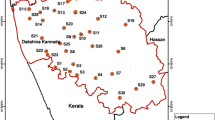Abstract
Radon (222Rn) and Thoron (220Rn) are radioactive noble gases which are produced in the decay chain of primordial radionuclides 238U and 232Th. These gases have been established as an important source of inhalation radiation dose to human which increases risk of lung cancer. Similarly the terrestrial 226Ra, 232Th, 40K are known to contribute to cumulative external background exposure to humans. In the present study, these radionuclides of concern were measured in the environment of monuments and museums in the state of Punjab and the resultant dose was calculated for the occupants. The calculated Annual Inhalation Dose level varied from 1.5 to 4.0 mSv with mean of 3.0 ± 0.8 mSv. The cumulative dose from all radionuclides 226Ra, 232Th and 40K is 47.0 ± 11.56 nGyh−1, found well within the safe limits of 86 nGyh−1.




Similar content being viewed by others
References
Kanse SD, Sahoo BK, Gaware JJ, Prajith R, Sapra BK (2016) A study of thoron exhalation from monazite-rich beach sands of High Background Radiation Areas of Kerala and Odisha, India. Environ Earth Sci 75:1465
Chauhan RP (2010) Monitoring of radon, thoron and progeny in dwellings of Haryana. Indian J Pure Appl Phys 48:470–472
Darby S, Hill D, Doll R (2001) Radon: a likely carcinogen at all exposures. Ann Oncol 12:1341–1351
Sahoo BK et al (2013) A new pin-hole discriminated 222Rn/220Rn passive measurement device with single entry face. Radiat Meas 58:52–60
Kudo H, Tokonami S, Omori Y, Ishikawa T, Iwaoka K, Sahoo SK, Akata N, Hosoda M, Wanabongse P, Pornnumpa C, Sun Q, Li X, Akiba S (2015) Comparative dosimetry for radon and thoron in high background radiation areas in China. Radiat Prot Dosimetry 167:155–159
Final Report of Tourism Survey for the State of Punjab for the period of July 2009–June 2010, Final Report Prepared by DMG Consulting Pvt. Ltd., Noida (PDF)
Mayya YS, Eappen KP, Nambi KSV (1998) Methodology for mixed field inhalation dosimetry in monazite areas using a twin-cup dosimeter with three track detectors. Radiat Prot Dosimetry 77(3):177–184
Mehta V, Kumar A, Singh SP, Chauhan RP, Mudahar GS (2015) Measurement of indoor radon, thoron and their progeny levels in dwellings of Union Territory Chandigarh, India: correlation with radon exhalation rates. Indoor Built Environ 24(6):833–842
Mehta V, Singh SP, Chauhan RP, Mudahar GS (2014) Measurement of indoor radon, thoron and their progeny levels in dwellings of Ambala district, Haryana, Northern India using solid state nuclear track detectors. Rom J Phys 59(7–8):834–845
Eappen KP, Mayya YS (2004) Calibration factors for LR-115 (type II) based radon thoron discriminating dosimeter. Radiat Meas 38:5–17
Kaur R, Shikha D, Singh SP, Mehta V (2019) Assessment of indoor radon and thoron in dwellings of Nangal area using SSNTD. J Geol Soc India 93(5):603–606
Rani A, Mittal S, Mehra R, Ramola RC (2015) Assessment of natural radionuclides in the soil samples from Marwar region of Rajasthan, India. Appl Radiat Isot 101:122–126
UNSCEAR (1988) United Nations Scientific Committee on the effects of atomic radiation, sources and effects of ionizing radiations. United Nations, New York
ICRP (1993), International Commission on Radiological Protection, ICRP Publication No. 65. Pergamon Press, Oxford
ICRP (1993) International Commission on Radiological Protection, Protection against radon-222 at home and at work, vol 23(2), pp 1–38
Martín SA et al (2012) Radon in workplaces in Extremadura (Spain). J Environ Radioact 107(2012):86–91
Quarto M et al (2015) Indoor radon activity concentration measurements in the great historical museums of university of Naples, Italy. Radiat Prot Dosimetry. https://doi.org/10.1093/rpd/ncv013
Alharbi SH, Riaz AA (2015) Radon and thoron concentrations in public workplaces in Brisbane, Australia. J Environ Radioact 144:69–76
Stojanovska Z et al (2014) Results from time integrated measurements of indoor radon, thoron and their decay product concentrations in schools in the Republic of Macedonia. Radiat Prot Dosimetry 162(1–2):152–156. https://doi.org/10.1093/rpd/ncu249
Singh P, Singh P, Singh S, Sahoo BK, Sapra BK, Bajwa BS (2015) A study of indoor radon, thoron and their progeny measurement in Tosham region Haryana, India. J Radiat Res Appl Sci 8:226–233
Acknowledgements
The authors, Dr. Deep Shikha and Dr. Vimal Mehta wants to thank BRNS-DAE funding (No. 56/14/01/2019-BRNS) and DST- FIST Scheme (No. SR/FST/College-2019-759 (C) for supporting this work.
Author information
Authors and Affiliations
Corresponding authors
Additional information
Publisher's Note
Springer Nature remains neutral with regard to jurisdictional claims in published maps and institutional affiliations.
Rights and permissions
About this article
Cite this article
Kaur, R., Shikha, D., Kaushal, A. et al. Measurement of indoor 222Rn, 220Rn and decay products along with naturally occurring radionuclides in some monuments and museums of Punjab, India. J Radioanal Nucl Chem 330, 1357–1364 (2021). https://doi.org/10.1007/s10967-021-07996-2
Received:
Accepted:
Published:
Issue Date:
DOI: https://doi.org/10.1007/s10967-021-07996-2




